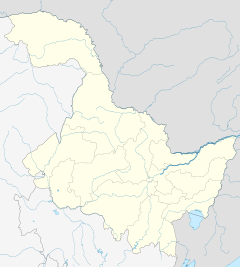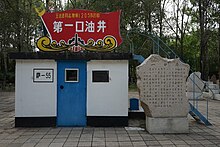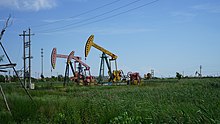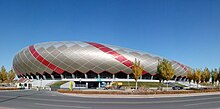| Daqing 大庆市 | |
|---|---|
| Prefecture-level city | |
 Around Sanyong Lake, 2017 Around Sanyong Lake, 2017 | |
 Location of Daqing City (yellow) in Heilongjiang (light gray) and China Location of Daqing City (yellow) in Heilongjiang (light gray) and China | |
  | |
| Coordinates (Daqing municipal government): 46°35′20″N 125°06′14″E / 46.589°N 125.104°E / 46.589; 125.104 | |
| Country | People's Republic of China |
| Province | Heilongjiang |
| County-level divisions | 9 |
| Government | |
| • Type | Prefecture-level city |
| • CPC Daqing Secretary | Han Lihua (韩立华) |
| • Mayor | He Zhonghua (何忠华) |
| Area | |
| • Prefecture-level city | 22,161 km (8,556 sq mi) |
| • Urban | 5,107 km (1,972 sq mi) |
| • Metro | 2,734.6 km (1,055.8 sq mi) |
| Elevation | 149 m (489 ft) |
| Population | |
| • Prefecture-level city | 2,781,562 |
| • Density | 130/km (330/sq mi) |
| • Urban | 1,754,655 |
| • Urban density | 340/km (890/sq mi) |
| • Metro | 1,574,389 |
| • Metro density | 580/km (1,500/sq mi) |
| GDP | |
| • Prefecture-level city | CN¥ 298.4 billion US$ 47.9 billion |
| • Per capita | CN¥ 107,419 US$ 17,247 |
| Time zone | UTC+8 (China Standard) |
| Postal code | 163000 |
| Area code | 0459 |
| ISO 3166 code | CN-HL-06 |
| Licence plates | 黑E |
| Climate | Dwa |
| Website | www |
| Daqing | |||||||||
|---|---|---|---|---|---|---|---|---|---|
 "Daqing", as written in Chinese "Daqing", as written in Chinese | |||||||||
| Chinese name | |||||||||
| Simplified Chinese | 大庆 | ||||||||
| Traditional Chinese | 大慶 | ||||||||
| Postal | Taching | ||||||||
| Literal meaning | Great Celebration | ||||||||
| |||||||||
| Mongolian name | |||||||||
| Mongolian Cyrillic | Дачин хот | ||||||||
| Mongolian script | ᠳᠠᠴᠢᠩ ᠬᠣᠲᠠ | ||||||||
| |||||||||
| Manchu name | |||||||||
| Manchu script | ᡩᠠᡴᡳᠩ ᡥᠣᡨᠣᠨ | ||||||||
| Romanization | Daking hoton | ||||||||
Daqing (simplified Chinese: 大庆; traditional Chinese: 大慶; pinyin: Dàqìng) is a prefecture-level city in the west of Heilongjiang province, People's Republic of China. The name literally means "Great Celebration" and refers to the tenth anniversary of the PRC. Daqing is known as the "Oil Capital of China" and has experienced a phenomenal boom since oil was discovered at the Daqing Oil Field in 1959.
Its population was 2,781,562 as of the 2020 census, of whom 1,574,389 lived in the built-up (or metro) area in four out of the total of five urban districts: Sartu, Longfeng, Ranghulu and Honggang.
History
The region now known as Daqing Prefecture was a reasonably insignificant place until the Qing dynasty, known only as an unsettled hunting ground of Dörbet Oirat tribes due to its wetland and prairies. The region began to grow slightly after the Russian Empire constructed the Chinese Eastern Railway (KVZhD) through the area in 1898. The railway has a station at Sartu in today's Sartu District. It was not until 1959 that oil was discovered in the region as part of the large scale oil exploration put into motion across the Northeast China Plain.
The Daqing oilfield was discovered in the late 1950s, and drilling began in 1958. A town with the same name was founded in 1959 to house workers extracting oil and gas from the oilfield and to host industries which could take advantage of the energy and petrochemicals, shortly before the 10th anniversary of the founding of the PRC. The successful construction of the Daqing oil field despite harsh weather conditions and supply limitations became a model held up by the Party as an example during subsequent industrialization campaigns. The project also delivered critical economic benefits because without the production of the Daqing oil field, crude oil would have been severely limited after the Soviet Union cut off supplies as a result of the Sino-Soviet split.
Original plans for Daqing included the development of a "new socialist mining district" (rather than a city) with families in which the husband would work in industry and the wife would work in agriculture.
The name Daqing literally means "Great Celebration". On 26 May 1960, Anda City was established at former Anda town (today's Anda City in Suihua prefecture), administering Daqing oilfield area. Five months later, the administrative organs of the oilfield relocated in Sartu. On 23 June 1964, the city was established Anda special administrative region, with Anda county administering its surrounding area.
The first two years of the Cultural Revolution resulted in major disruptions to China's petroleum industry and an oil shortage by 1967. In March of that year, the People's Liberation Army was called to Daqing to maintain order so that oil production could proceed. This made Daqing one of the first places brought under military control during the Cultural Revolution. In May 1968, the Daqing Revolutionary Committee was established. Iron Man Wang Jinxi became its vice director. The oil field continued to be a major driver of economic growth during the chaotic Cultural Revolution period.
The Daqing Oil District became a city in 1980. Its first master plan set a goal of growing Daqing into "a new industrial city" through a development strategy of "relative dispersion with several modest concentrations. Academic Hou Li summarizes that as a result "new settlements became much more concerntrated. The three existing towns, thirty-four central villages, and 260 settlement points were restructured into six workers' towns, twenty-four central villages, and twenty-seven resident villages."
The city revised its master plan in 1989, setting a new goal of building an oil city centered in Saertu, Dongfeng, and Longfeng. This plan shifted Daqing's urban planning focus away from decentralization to centralization.
In 1990, the city received the top recognition in the Heilongjiang Province Science and Technology Awards. In 1994, its population reached one million. After the mid-1990s, urban expansion in Saertu was halted in order to provide more space for oil production. Urban construction was instead transferred to East Town and West Town areas.
Since its foundation, Daqing has been advocated as a model of good practice in industry and healthcare by the Chinese government.
Learn from Daqing in industry
The fact that Mao Zedong promulgated his Supreme Directive, Learn from Daqing in Industry, in the 1960s reflects how important a role Daqing has historically played in industry in China. Learn from Daqing in industry (Chinese: 工业学大庆; pinyin: gōngyè xué dàqìng) was a slogan during the Cultural Revolution telling the people to use the city as an example for industrial production.
The film Entrepreneurial Pioneers (创业), made in the early 1970s, is a literary rendition of the history of Daqing. During the Mao era, Daqing's agricultural counterpart was Dazhai, a village in the hilly Xiyang county, Shanxi Province, for which Chairman Mao issued the directive In agriculture, learn from Dazhai, also in the 1960s.
Administrative divisions
Daqing is divided into 9 county-level divisions: 5 districts, 3 counties and 1 autonomous county.
| Map | |||||
|---|---|---|---|---|---|
 Sartu
Longfeng
Ranghulu
Datong
Honggang
Zhaozhou
Sartu
Longfeng
Ranghulu
Datong
Honggang
ZhaozhouCounty Zhaoyuan County Lindian County Dorbod County | |||||
| Name | Simplified Chinese | Hanyu Pinyin | Population (2010 census) |
Area (km) |
Density (/km) |
| Sartu District | 萨尔图区 | Sà'ěrtú Qū | 328,808 | 549 | 599 |
| Longfeng District | 龙凤区 | Lóngfèng Qū | 352,404 | 510 | 691 |
| Ranghulu District | 让胡路区 | Rànghúlù Qū | 564,534 | 1,394 | 405 |
| Datong District | 大同区 | Dàtóng Qū | 234,557 | 2,235 | 105 |
| Honggang District | 红岗区 | Hónggǎng Qū | 169,522 | 812 | 209 |
| Zhaozhou County | 肇州县 | Zhàozhōu Xiàn | 387,463 | 2,445 | 158 |
| Zhaoyuan County | 肇源县 | Zhàoyuán Xiàn | 388,828 | 4,198 | 93 |
| Lindian County | 林甸县 | Líndiàn Xiàn | 244,578 | 3,591 | 68 |
| Dorbod Mongol Autonomous County | 杜尔伯特蒙古族自治县 | Dù'ěrbótè Měnggǔzú Zìzhìxiàn | 233,838 | 6,427 | 36 |
Climate
Located in the north temperate zone, Daqing has a humid continental climate (Köppen Dwa) and is affected by the Siberian high and the East Asian monsoon. Generally, winter is bitterly cold with occasional snowfalls, and spring and autumn are prevailed by monsoons. The vast majority of the annual rainfall occurs during summer. The diurnal temperature variation can be up to 14 °C (25 °F) during the growing period. The monthly 24-hour average temperature ranges from −18.5 °C (−1.3 °F) in January to 23.3 °C (73.9 °F) in July, and the annual mean is +4.2 °C (39.6 °F). A majority of the annual precipitation falls in July and August alone. With monthly percent possible sunshine ranging from 53% in July to 70% in February, the city receives 2,726 hours of bright sunshine annually. Extreme temperature ranges from −39.2 °C (−38.6 °F) to 39.8 °C (103.6 °F)
| Climate data for Daqing (1991–2020 normals) | |||||||||||||
|---|---|---|---|---|---|---|---|---|---|---|---|---|---|
| Month | Jan | Feb | Mar | Apr | May | Jun | Jul | Aug | Sep | Oct | Nov | Dec | Year |
| Mean daily maximum °C (°F) | −11.7 (10.9) |
−6.9 (19.6) |
2.9 (37.2) |
13.5 (56.3) |
21.5 (70.7) |
26.7 (80.1) |
28.5 (83.3) |
26.9 (80.4) |
21.5 (70.7) |
12.3 (54.1) |
−0.3 (31.5) |
−10.3 (13.5) |
10.4 (50.7) |
| Daily mean °C (°F) | −16.5 (2.3) |
−12.2 (10.0) |
−2.5 (27.5) |
7.8 (46.0) |
15.8 (60.4) |
21.4 (70.5) |
24.0 (75.2) |
22.2 (72.0) |
16.0 (60.8) |
6.9 (44.4) |
−4.8 (23.4) |
−14.6 (5.7) |
5.3 (41.5) |
| Mean daily minimum °C (°F) | −20.6 (−5.1) |
−17.0 (1.4) |
−7.5 (18.5) |
2.2 (36.0) |
10.3 (50.5) |
16.4 (61.5) |
19.6 (67.3) |
17.9 (64.2) |
11.1 (52.0) |
2.2 (36.0) |
−8.6 (16.5) |
−18.3 (−0.9) |
0.6 (33.2) |
| Average precipitation mm (inches) | 2.4 (0.09) |
3.8 (0.15) |
8.8 (0.35) |
18.9 (0.74) |
49.0 (1.93) |
100.7 (3.96) |
145.8 (5.74) |
97.3 (3.83) |
50.3 (1.98) |
19.1 (0.75) |
6.2 (0.24) |
5.9 (0.23) |
508.2 (19.99) |
| Average precipitation days (≥ 0.1 mm) | 3.6 | 2.7 | 4.3 | 5.7 | 9.6 | 13.5 | 13.1 | 11.3 | 7.8 | 4.8 | 4.1 | 5.3 | 85.8 |
| Average snowy days | 5.5 | 4.9 | 5.5 | 2.3 | 0.1 | 0 | 0 | 0 | 0 | 1.1 | 5.5 | 8.1 | 33 |
| Average relative humidity (%) | 64 | 58 | 51 | 44 | 52 | 64 | 73 | 73 | 65 | 56 | 60 | 66 | 61 |
| Mean monthly sunshine hours | 181.6 | 194.2 | 237.5 | 230.9 | 235.3 | 220.9 | 211.8 | 211.9 | 222.6 | 199.8 | 158.7 | 152.4 | 2,457.6 |
| Percent possible sunshine | 65 | 66 | 64 | 56 | 51 | 47 | 45 | 49 | 60 | 60 | 57 | 58 | 57 |
| Source: China Meteorological Administration | |||||||||||||
Demographics
Daqing has a population of 2.9 million, of them mainly Han Chinese, with a few population of other 31 minority ethnic groups including Manchu, Mongolian, Korean, and Hui nationalities. The population density is 112.69/km, urban population density 205.07/km.
Economy


Daqing's economy highly depends on petroleum and related industries. Daqing's oilfield is China's largest and the world's fourth most productive. Petroleum accounts for 60.8% of GDP. In 2011, Daqing's gross domestic product (GDP) was RMB374 billion yuan, representing a rise of 12.1% year on year. Primary industries output (including agriculture, forestry, animal husbandry and the fisheries) increased by 13.5% to RMB13.29 billion. Secondary and value-added industries and construction output experienced an increase of 10.1%, reaching RMB307 billion, while the tertiary industry output increased 22.9% to RMB53.74 billion. In 2015 Daqing had a GDP of RMB 298.35 billion.
Foreign trade
Daqing exports over 10 million tons of crude oil each year. Over 160 varieties of paraffin wax, ethylene, tar oil and benzene are exported to more than 10 nations and regions including the US, the UK, Thailand and Hong Kong.
In 2011, total import and export volume in Daqing reached US$2.16 billion, up by 40.1%. Export volume was US$550 million and import volume was US$1.61 billion. Daqing's main exports include six categories of petrochemical products, construction materials, processed foodstuffs, office furniture and mechanical and electronic equipment.
Banking and insurance
There were 32 banking institutions in Daqing by the end of 2006; none were foreign-invested banks. In 2011, savings deposits in Renminbi and foreign exchange totaled 170.5 billion RMB. The local finance sector plays an important role in building up Daqing's Century Oilfield and in developing new industries.
The Industrial and Commercial Bank of China, China Agricultural Bank, China Construction Bank, Bank of China, China Communications Bank, the Everbright Bank, Guangdong Development Bank, the Daqing Urban Commercial Bank, Daqing Rural Credit Cooperative Union and the County Urban Credit Cooperative are the major banks serving Daqing.
Transportation

Railway
Daqing is a major railway hub in western Heilongjiang province and is located on the junction of Harbin-Manzhouli Railway and Tongliao-Ranghulu Railway. Daqing has three major railway stations: Daqing station, Daqing West station (formerly Ranghulu railway station) and Daqing East station. Trains from Daqing connect the city with Beijing, Harbin, Dalian and several other cities in China. The newly built Harbin–Qiqihar Intercity Railway has stops at both Daqing West station and Daqing East station.
Airport
Main article: Daqing Sartu AirportDaqing Sartu Airport was opened on 1 September 2009. There are flights to several large cities including Beijing, Chengdu, Guangzhou, Hangzhou, Qingdao and Shanghai.
Highway
Daqing is linked to the national highway network through the G45 Daqing–Guangzhou Expressway and G10 Suifenhe-Manzhouli Expressway.
Culture


Daqing spirit
Generated by the history of the city, Daqing has a culture centering around the "Daqing Spirit, the Daqing People," which is said to represent deep personal commitment in pursuing national goals, self-sufficient and frugal living, and urban-rural integrated land use. Daqing's urban-rural landscape was said to embody the ideal communist society described by Karl Marx because it eliminated (1) the gap between town and country, (2) the gap between workers and peasants, and (3) the gap between manual and mental labor.
"Daqing Spirit, Daqing People" was the title of an April 20, 1964 article in People's Daily which extolled the success of Daqing oil field workers. The most influential of many articles praising Daqing that appeared in state media around that time, "Daqing Spirit, Daqing People" was the first text to compare Daqing to Yan'an, the revolutionary base area where the Communist Party re-grouped following the Long March before going on to win the Chinese Civil War.
Wang Jinxi (Chinese: 王进喜; pinyin: Wáng Jìnxǐ, known as "Iron Man" Wang), a petroleum worker on the Daqing Oilfield who led No. 1205 drilling team, was honored as a national hero due to his contributions to the petroleum industry of China. Daqing was established by the central government as a model for the secondary industry during the 1960s. In order to illuminate the entrepreneurial history of Daqing and its people, several films were made by companies in China.
In 1964, chief director of the Central Experimental Theater Sun Weishi and her husband, the actor Jin Shan, traveled to Daqing to live and work with the oil workers and their families. The next year, the Communist Party journal Red Flag published an article by Sun which praised the Daqing people. After living in Daqing for two years, Sun Weishi returned to Beijing to produce the play The Rising Sun, which was based on the experiences of people in Daqing, particularly Daqing women.
Sports

The most popular sport in Daqing is association football. The largest sports venue by capacity is the 32,000-capacity Daqing Olympic Park Stadium.
Sister Cities
| This section does not cite any sources. Please help improve this section by adding citations to reliable sources. Unsourced material may be challenged and removed. (August 2018) (Learn how and when to remove this message) |
Domestic
International
 East London, Eastern Cape, South Africa
East London, Eastern Cape, South Africa Calgary, Alberta, Canada
Calgary, Alberta, Canada Tyumen, Tyumen Oblast, Russia
Tyumen, Tyumen Oblast, Russia Chungju, North Chungcheong, South Korea
Chungju, North Chungcheong, South Korea
See also
References
- "China: Hēilóngjiāng (Prefectures, Cities, Districts and Counties) - Population Statistics, Charts and Map".
- ^ Hou, Li (2021). Building for Oil: Daqing and the Formation of the Chinese Socialist State. Harvard-Yenching Institute monograph series. Cambridge, Massachusetts: Harvard University Asia Center. ISBN 978-0-674-26022-1.
- ^ 1959年发现大庆油田:中国结束油荒历史. Netease (in Chinese). 16 September 2014. Archived from the original on 10 December 2017. Retrieved 17 July 2015.
- 滨州铁路简介. 火车旅行网. Archived from the original on 21 February 2013. Retrieved 17 July 2015.
- ^ Meyskens, Covell F. (2020). Mao's Third Front: The Militarization of Cold War China. Cambridge, United Kingdom: Cambridge University Press. doi:10.1017/9781108784788. ISBN 978-1-108-78478-8. OCLC 1145096137. S2CID 218936313.
- Harrell, Stevan (2023). An Ecological History of Modern China. Seattle: University of Washington Press. ISBN 9780295751719.
- ^ "The Industry Learns From Daqing..." Chineseposters.net. Retrieved April 30, 2011.
- Spence's The Search for Modern China. 2nd Edition, pages: 563, 564, 605, 606, 619
- Spence's "The Search for Modern China" 2nd Edition, p.562
- 中国气象数据网 – WeatherBk Data (in Simplified Chinese). China Meteorological Administration. Retrieved 27 September 2023.
- "Experience Template" 中国气象数据网 (in Simplified Chinese). China Meteorological Administration. Retrieved 27 September 2023.
- 2010年大庆市第六次全国人口普查主要数据公报 (in Chinese). Government of Daqing. 9 May 2011. Archived from the original on 19 June 2017. Retrieved 17 July 2015.
- ^ 2011年大庆市国民经济和社会发展统计公报. Daqing Municipal Bureau of Statistics. Archived from the original on 16 May 2012. Retrieved 26 July 2012.
- 2015年黑龙江各市GDP和人均GDP排名.
- ^ "Daqing Business Guide - Economic Overview". echinacities.com. Archived from the original on 2 December 2012. Retrieved 26 July 2012.
- 大庆萨尔图机场正式通航. People.com.cn (in Chinese (China)). Archived from the original on 2016-03-04. Retrieved 2012-07-26.
- Profiles of China Provinces, Cities and Industrial Parks
- "What do you know about Calgary's six sister cities? | News". dailyhive.com. Retrieved 2023-06-06.
External links
- Daqing Government Website Archived 2016-01-27 at the Wayback Machine
| County-level divisions of Heilongjiang Province | |||||||||||||||||||||||
|---|---|---|---|---|---|---|---|---|---|---|---|---|---|---|---|---|---|---|---|---|---|---|---|
| Harbin (capital) | |||||||||||||||||||||||
| Sub-provincial city |
| ||||||||||||||||||||||
| Prefecture-level cities |
| ||||||||||||||||||||||
| Prefecture |
| ||||||||||||||||||||||
| These are administrative zones, which are not standard units of local government, though they do function as such.
Formally part of Oroqen Banner in Inner Mongolia but administered de facto by Daxing'anling Prefecture in Heilongjiang. Formally part of Huma County. | |||||||||||||||||||||||